How to Lower the pH in Your Fish Tank
Proper Aquarium pH
Before learning how to lower the pH in your fish tank, let’s discuss what pH you should actually be striving for. The main thing to note, is that it’s more important to maintain a consistent pH than it is to be constantly modifying it while undergoing rapid swings in acidity. Fish can adjust and become used to pH levels (within a certain range) so it is best to keep them in a stable environment once they have adapted. If you are not sure what pH your fish desire to live in, you can refer here to this guide.
Learning to lower the pH in your fish tank is a valuable procedure to learn because many aquatic plants and fish thrive in a lower pH range of 6.5 – 7.0 while tap water is commonly found between 7.5 – 8.2. A self-sustaining aquarium is always what we want to strive for. It’s good to use a combination of natural methods, to reduce and maintain a low pH. But also quick methods, to initially bring us to the desired pH.
Natural Ways to Lower the pH in your Fish Tank
Reduce Light Cycle
When your aquarium light is turned on, plants go through photosynthesis and convert carbon dioxide to oxygen. Reducing your aquarium light cycle slows down this process because as the lights are off, your fish will continue to convert oxygen into carbon dioxide leading to an increase in CO2 levels and a decrease in pH. Between 8 and 12 hours is recommended for lights to be on. You’ll want to scale your lights back but find a healthy balance within that range.
Driftwood
Driftwood releases tannic acid into your aquarium making the water more acidic. It is a slow process reducing the pH with driftwood. I would not expect it to reduce by more than .3-.5 pH over a few weeks time. Driftwood is great for maintaining a low aquarium pH more so than it is for quickly adjusting it.
Driftwood also has the opportunity to turn your water a dark amber color if not thoroughly rinsed…
The amber water is not dangerous to your fish, but it’s obviously not ideal if you prefer crystal clear tank water. The first time I added driftwood to my tank, I poured boiling water over the wood in a 5 gallon bucket, secured the lid, and let it sit for 3 hours. I dumped the now dark amber water into my tub. Then thinking I removed all of the contaminants, I added the wood into my tank. It only took a matter of days before my tank water was completely brown. Not until I had repeated the process for an additional 6 hours, did the wood finally stop tinting my aquarium water.
My recommendation for preparing driftwood would be to soak it in boiling water one afternoon for about 5 hours. Then repeat the process with refreshed hot water overnight. Totaling over 12 hours of soaking the driftwood should almost always put you in the clear.
If you’d like, you can check out various aquarium safe driftwood here.
Plus, here is the wood that I use in my planted tank (pictured below) which I have really liked the look of. But remember, choosing hardscape is all about the look you want to go for!
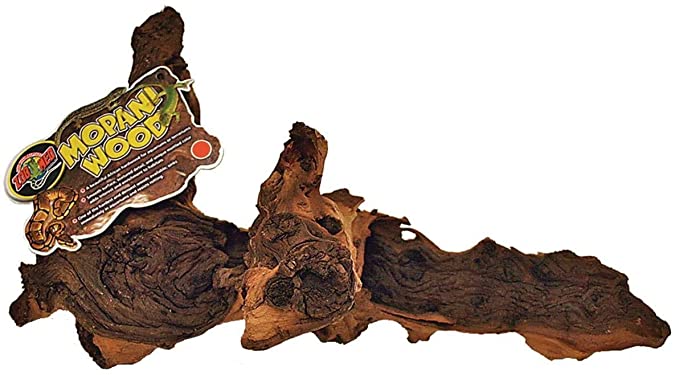
Peat Moss
Peat moss works in the same way as driftwood; by releasing tannic acid into your water.
Similarly, it must be rinsed in order to prevent tinting your aquarium water. You can decorate your tank with it or you can even add it to a pouch to insert into your filter and run the water through (shown below). I recommend this method so you can keep track of pH change over time. Just remove it when you have achieved the desired pH level.
I have used these peat granules and this filter pouch with success in the past. The pouch also comes in handy if you ever want to run your water through carbon, zeolite, bio cubes, etc.
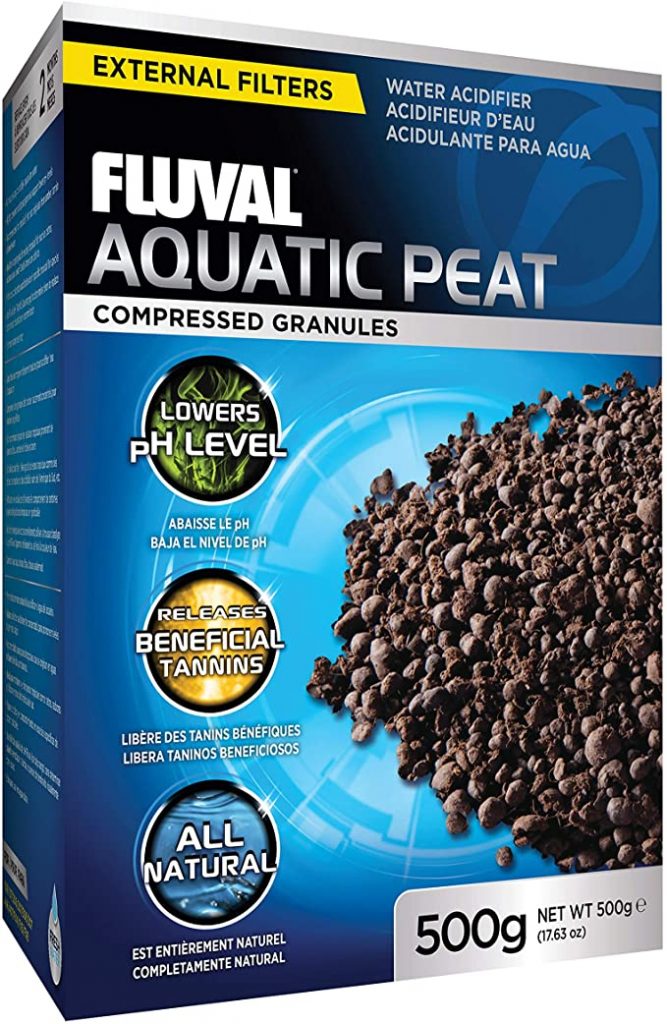
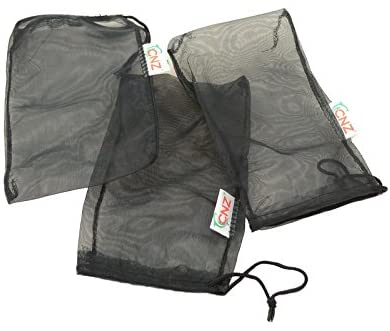
Indian Almond Leaves
Also known as Catappa Leaves. Just place the leaves directly into your aquarium and let them slowly decompose. For quicker results, crush the leaves in water, strain leaf particles, and pour the water into your tank.
Catappa leaves also offer antibacterial and breeding properties. The antibacterial properties have been observed to help ill fish affected by diseases such as fin rot.
Indian Almond Leaves can also be used to stimulate shrimp and betta fish breeding. It does so by creating water conditions that are more familiar to their native region. These are harder to come across in stores so I’ve just bought this brand of Almond Leaves on Amazon before because they are cheap and geared for the aquarium hobby.
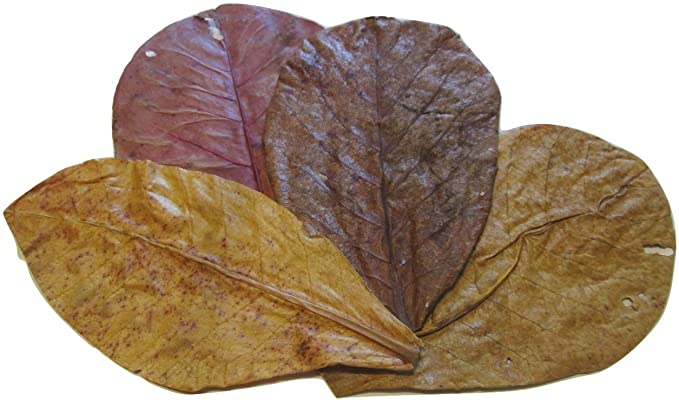
Increase CO2
CO2 is what your plants need to thrive as they complete the oxygen cycle with the aquarium fish. In addition to providing for plants, increasing CO2 can lower the pH in your fish tank. So if you are trying to lower pH and increase plant growth, adding a CO2 system may be the best course of action to take. Especially since it is a stable and more permanent solution for maintaining a lower pH.
If you are not ready to invest in a CO2 system, or you feel that your tank does not have enough plants to demand one, you can check out liquid CO2 booster as a quick and more cost effective solution.
Quick Ways to Lower the pH in your Fish Tank
Add RO Water
This only works if the pH of the RO water is less than the pH of your aquarium. But since RO water is ideally just H2O molecules, the pH is typically 7.0 so it is often less than that of your tap water. If you’re trying to reduce the pH of an aquarium with a pH over 7.1, you can add RO water to make the water more acidic (decrease pH).
RO water can be purchased at most aquarium supply stores apart from big chains like PetSmart and Petco. Reef aquarium stores will surely have it for sale but you will want to bring your own bucket. I bring a 5 gallon bucket or two to prevent having to buy a bucket at the store.
Add pH Down Solution (Fastest Method)
In the end, you want to strive for a chemical free tank. This is true. But take for example that you have a pH of 8.0 and want to move it to 6.5. If you do all of the natural methods listed above, it may only drop to the 7.5 range after a few weeks. Doing the natural methods are perfect for sustaining a low pH, but getting to that range initially is best done by the addition of a pH down solution. I recommend this brand as they have been trusted in the industry the longest and are also the best price for the amount you get.
So those are my favorite methods to lower the pH in your fish tank! Let me know what questions you may have in the comments below and thanks so much for reading!
References:
Featured Image: https://www.plantedtank.net/forums/12-tank-journals/93764-solids-29-gallon.html
Almond Leaf Info: https://www.ncbi.nlm.nih.gov/pubmed/23885412
Almond Leaf Pic: Click Here
CO2 Pic: https://www.theaquariumguide.com/articles/co2-diffuser-purpose






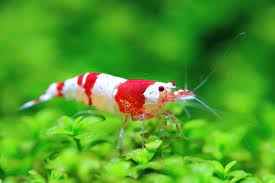



















Add comment